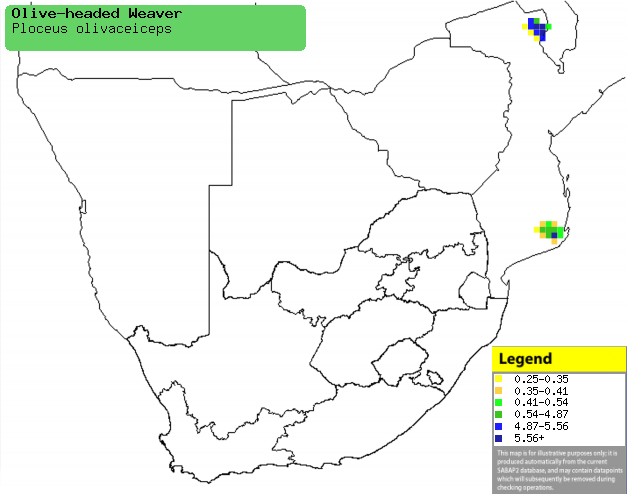|
Ploceus olivaceiceps
(Olive-headed weaver)
Olyfkopwewer [Afrikaans]; Olijfkopwever [Dutch];
Tisserin à tête olive [French]; Olivenkopfweber [German];
Tecelão-de-cabeça-olivácea [Portuguese]
Life
> Eukaryotes >
Opisthokonta
> Metazoa (animals) >
Bilateria >
Deuterostomia > Chordata >
Craniata > Vertebrata (vertebrates) > Gnathostomata (jawed
vertebrates) > Teleostomi (teleost fish) > Osteichthyes (bony fish) > Class:
Sarcopterygii (lobe-finned
fish) > Stegocephalia (terrestrial
vertebrates) > Tetrapoda
(four-legged vertebrates) > Reptiliomorpha > Amniota >
Reptilia (reptiles) >
Romeriida > Diapsida > Archosauromorpha > Archosauria >
Dinosauria
(dinosaurs) > Saurischia > Theropoda (bipedal predatory dinosaurs) >
Coelurosauria > Maniraptora > Aves
(birds) >
Order: Passeriformes > Family: Ploceidae
> Genus: Ploceus
Distribution and habitat
Occurs in small, localised patches in southern Tanzania,
eastern Zambia and northern Mozambique, with an isolated population near Panda
in southern Mozambique. It generally favours mature miombo (Brachystegia)
woodland with plentiful old-man's-beard lichen (Usnea), while near Panda
it only occupies miombo woodland with scattered Munondo (Julbernardia)
and an understorey of torchwood (Balanites).
|
 |
|
Distribution of Olive-headed weaver in southern Africa,
based on statistical smoothing of the records from first SA Bird Atlas
Project (©
Animal Demography unit, University of
Cape Town; smoothing by Birgit Erni and Francesca Little). Colours range
from dark blue (most common) through to yellow (least common). |
Food
It mainly eats insects, doing most of its foraging in the
tree canopy, gleaning prey from trunks and branches. It often joins
mixed-species foraging flocks, along with
Spotted creepers,
wood-hoopoes,
woodpeckers,
orioles, cuckoos,
crombecs,
hyliotas,
cuckooshrikes and
Black-backed puffbacks. The following food items have been recorded
in its diet:
Breeding
- The nest is built by both sexes, consisting of a thick-walled ball of
old-man's-beard lichen (Usnea) with a vertical entrance tunnel. It is
typically suspended from a branch in the tree canopy up to about 18 metres
above ground, attached to the same lichen it is built with, effectively
camouflaging it.
- Egg-laying season is from August-October.
- It lays 2-3 eggs, which incubated by both sexes but mainly the female,
taking breaks every 30-50 minutes or so to go and forage with the male.
- Little is known about the young, other than that they are fed by both
sexes, but with the female contributing more food.
Threats
Globally Near-threatened due its localised and
fragmented population, which is caused by habitat loss from aforestation, plus
the fact that it doesn't occur in any protected areas in southern Africa.
References
-
Hockey PAR, Dean WRJ and Ryan PG 2005. Roberts
- Birds of southern Africa, VIIth ed. The Trustees of the John Voelcker
Bird Book Fund, Cape Town.
|
